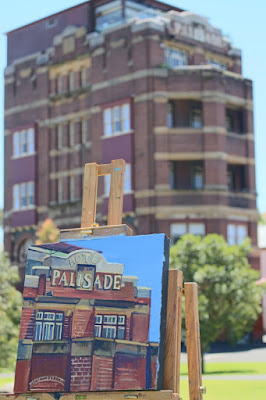There's just so much history in the walls of the Palisade.
It was the scene of the last drinks for many Anzacs before they left Australia during the First World War, and the 'local' for the engineers and navvies working on the construction of the Sydney Harbour Bridge. Desperate wharfies seeking work at the Hungry Mile during the Great Depression would either drown their sorrows or celebrate their good fortune in finding a day's work, depending on luck. It was the haunt of 'colourful characters', the much loved centre of the Millers Point community and the headquarters of activists during the era of the Green Bans and the Patrick's dispute.
It stood on the corner of Argyle and Bettington streets in Millers Point like an exclamation point at the end of High street. For many years it was the tallest building in Sydney, and overlooked the wharves of East Darling Harbour which provided most of its clientele. At the time of its building, workers terraces to house the wharfies were being constructed in High Street which was carved into the sandstone escarpment above the Fingerwharves and Bond stores below.
This painting shows one of the landbridges over Hickson Road, and the railings preventing revellers falling into the deep cutting in front of the Palisade. This strange configuration of the landscape makes the quirky, slightly ramshackle style of the Palisade even more startling.
In 2014, when I painted this canvas, there was a small park in front of the Palisade. It was overgrown, but its figtrees were a welcome source of shade in summer. Since the redevelopment of this area, the park is now a wide green lawn with a few saplings which will need a lot of time before they provide shade.
MP7A Hotel Palisade 2014
oil on canvas 36 x 46cm
Available
There had been an earlier, much smaller hotel built on this site in the 1880s but it was pulled down in the frenzy of slum clearances at the beginning of the 20th century.
After the end of the bubonic plague crisis in the first decade of the 20th century, the population in Millers Point increased so much that the Sydney Harbour Trust had to build replacement hotels to cater to the port workers. Henry Deane Walsh was commissioned to build the new Palisade Hotel, one of 4 that were built by the Trust, the others being Dumbarton Castle, the 'Big House' (Moretons in Sussex Street- now the Sussex Hotel) and the Harbour View Hotel. 
MP30 The Reopening of the Palisade
2015 oil on canvas 51 x 25cm
Enquiries about similar paintings
The 5 storey hotel was built in 1915-16, and was one of the last Sydney buildings to be designed in the 'Federation Free' style, with parapets, and sandstone banding decorating the red brick masonry.
From the 1920s the head lease for the hotel was owned by Tooth and Co. who sub let it to various licensees.
MP30 The Reopening of the Palisade
2015 oil on canvas 51 x 25cm
Enquiries about similar paintings
From
1936, when the role of the Sydney Harbour Trust was taken over by the
newly formed Maritime Service Board, title to the hotel was issued to
the MSB, although Tooths continued to lease it until 1950. At that time
the licensee, P. K. Armstrong, obtained the lease.
In February 1987 title passed from the MSB into private ownership, then in 1994, Palisade Properties Pty Ltd obtained title.

MP30 The Reopening of the Palisade
2015 oil on canvas 51 x 25cm

MP30 The Reopening of the Palisade
2015 oil on canvas 51 x 25cm


























